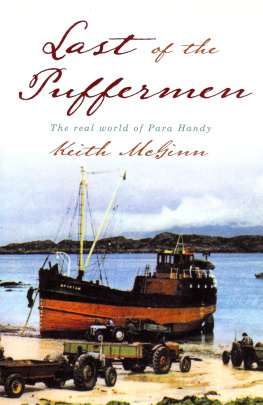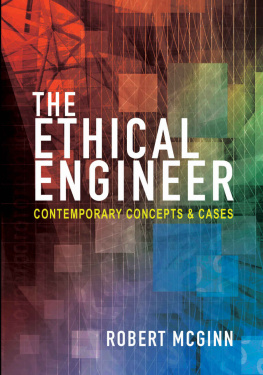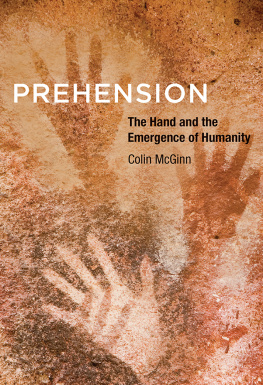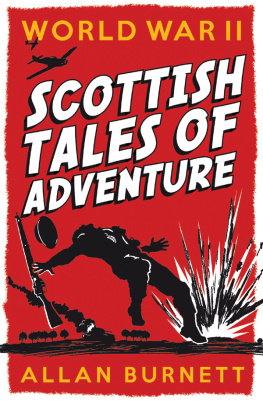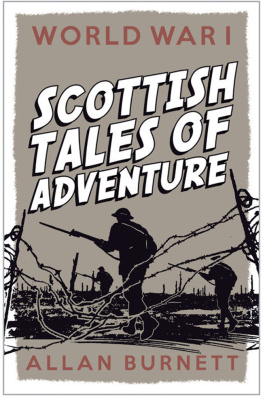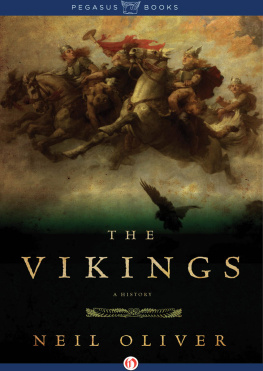An excellent account of a now vanished and very hard way of life. The author, while not totally dispassionate, gives a fair account of what must have been a very tough life. Despite that toughness he obviously enjoyed the life and the people that it brought him into contact with ... I love the Para Handy tales but this book is already higher in my estimation than those. It is that good.
Review by Sam Maxwell on Amazon
The Last of the Puffermen
THE REAL WORLD OF PARA HANDY
KEITH McGINN
I would like to dedicate this book to all the men still
alive today who worked and sailed on the puffers prior to 1970,
as you truly are The Last of the Puffermen.
Edward Keith McGinn
Contents
Acknowledgements
I would like to thank, most sincerely, all the people who helped and encouraged me in the writing of this book. Len Paterson edited my manuscript, added photographs and made the book much more complete than I could ever have envisaged. He also kindly contributed the introduction. My thanks are also due to Neil Wilson for taking on my work and turning it into a published book. To Captain Andy Milner and his colleague Ann MacDonald who typed my original hand-written effort and sorted out my spelling mistakes, to my brother-in-law, Professor Jim Rhodes and to Andy Low who read my early writings and encouraged me to carry on writing, my grateful thanks.
Last, but not least, thanks to my wife, Jo, who put up with me sailing on the puffers for all those years and tolerated me being away from home most of our married life.
E.K. McG.
Introduction
K eith McGinn speaks with the authentic voice of the pufferman. He worked on these small boats that serviced the West Highlands and Islands of Scotland from the 1960s to the closure of the trade in 1994.
He worked as a deckhand on the last days of the 66-ft canal boats, (the classic puffer design) and eventually became a skipper in charge of a coaster, still working on the West Coast, that could carry five times the cargo of the small vessel in which he started his career. He tells his warts-and-all story as it was. He does not glamorise the life though he enjoyed good times and companionship. He does not minimise the dangers, tragedies and hardships either. He lived and worked in unique times and in a real sense he is one of the last of the puffermen.
For about 20 years of the time he describes I was part of the management team at Glenlight Shipping Ltd, one of the last of the puffer companies. My part in this book has been to structure the narrative, add some footnotes and this introduction by way of explanation for the general reader.
Glenlight Shipping Ltd was formed in 1968 by uniting the interests of the two larger long-established puffer companies, Hay-Hamilton Ltd. and Ross & Marshall Ltd., who came together after they lost their trade to Islay with the advent of the roll-on-roll-off ferries. The presence of the publicly subsidised ferries and the increasing trend to use road transport depressed freight rates for the puffers to the point where the business of servicing the West Highlands became unprofitable. This happened despite Glenlight investing heavily in larger ships to try to reap the benefits of the economies of size as Keith describes.
Yet the ferries could not effectively carry the bulk commodities that the Highlands and Islands needed. In 1980 an accommodation was reached with the Scottish Office under the Highlands Shipping Act to directly subsidise the trade and also reduce the cost to the cargo recipient through the Tariff Rebate Subsidy. This was achieved at a fraction of the cost of subsidising the ferries. Government terminated this arrangement in 1994 precipitating the closure of the puffer trade. Keith and his fellow seamen became redundant.
Keith records in the final chapter, The bosses fought like hell to keep the firm going and save our jobs. We tried. Thanks for the compliment, Keith.
Len Paterson, February 2009
A puffer, seen here in the Upper Harbour, Glasgow, and built by Ross & Marshall Ltd in the 1930s. She is a typical example of the pre-World War II steam lighter and of a design that had changed little for a quarter of a century Her 66-ft length and 18-ft beam meant that she could pass through the locks of the Forth and Clyde and Crinan canals. She could carry about 120 tons of coal when fully loaded.
There was no enclosed wheelhouse and the helmsman was exposed to the elements, though he could be partly protected by a canvas dodger. Both the mast and the funnel could be lowered to allow her to pass under the bridges seen in the background. Her 34-ft long cargo hatch was closed by wooden hatch boards made waterproof by a tarpaulin held in place by wooden chocks.
In the bow was the steam-driven winch which operated her cargo lifting gear. The derrick is seen lying down the centre line of the vessel and resting on the top of the engine-room casing. Underneath this area, in the focsle, was the cramped accommodation for three men, in a space about 15-ft long. The davit, used for raising and lowering both the anchor and the lifeboat, is seen on the left side at the bow.
For economic reasons in the 1950s these vessels were superseded by diesel-driven puffers of some 80-ft length which could be accommodated in the locks of the Crinan. At the same time, and for the same reasons, some of the 66-ft steam puffers were converted to diesel propulsion and the redesign of the aft end, made possible by the removal of the boiler and coal bunkers, allowed for the provision of improved crew accommodation.
The Lady Isle and Lady Morven, the ships of the Irvine Shipping and Trading Company, in which the author first went to sea in the 1960s, were diesel conversions of steam puffers. Courtesy of the Ballast Trust
CHAPTER 1
The Start
M y introduction to the puffers came in the summer of 1965. At that time, I worked for Ayr Burgh Water Department at their treatment plant at Knockjarder, outside Dalrymple, near Ayr, in the days before regionalisation.
A new family had moved to the village. Hughie Gibson got a start at the waterworks; so he and I were paired together on any two-man jobs. He was a good laugh and very streetwise. Hughie had a young family of four kids to bring up but I soon found out that he was not very enthusiastic about work. After being there for about a month, he asked me one day, What age are you?
Twenty-one I replied.
No, no, he said, you cant be, you are about fifty-two or fifty-three!
Im twenty-one past on 4th February, I was born in 1944, I replied but he said he had heard me talking in the bothy with old Connel, Jimmy Barr, Sandy Wallace and Archie MacGregor (all men in their late fifties).
Did you see Corrie last night? That was some row between Elsie Tanner and Ena Sharples! Poor old Minnie Caldwell, she was in the middle of it. And did you watch Wagon Train? That was a good story. What do we get tonight, Tuesday? Thats Emergency Ward 10 and tomorrow we get Corrie and then Z Cars. Did you hear wee Isa Smith won 10 at the bingo on Saturday night? Aye! She had to use the money to bail her son out on Sunday morning! Big Mays still going out with Tommy Robertson. If Tommys wife finds out shell tear Big Mays heid off!

